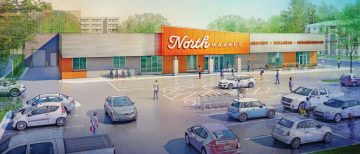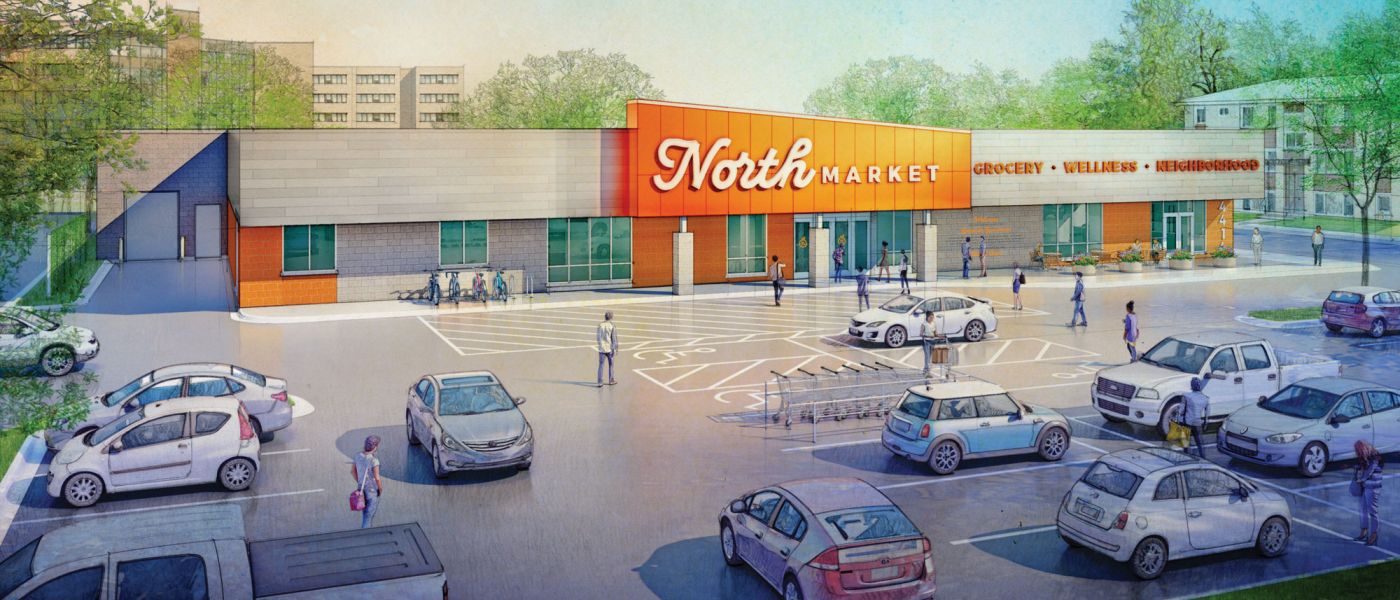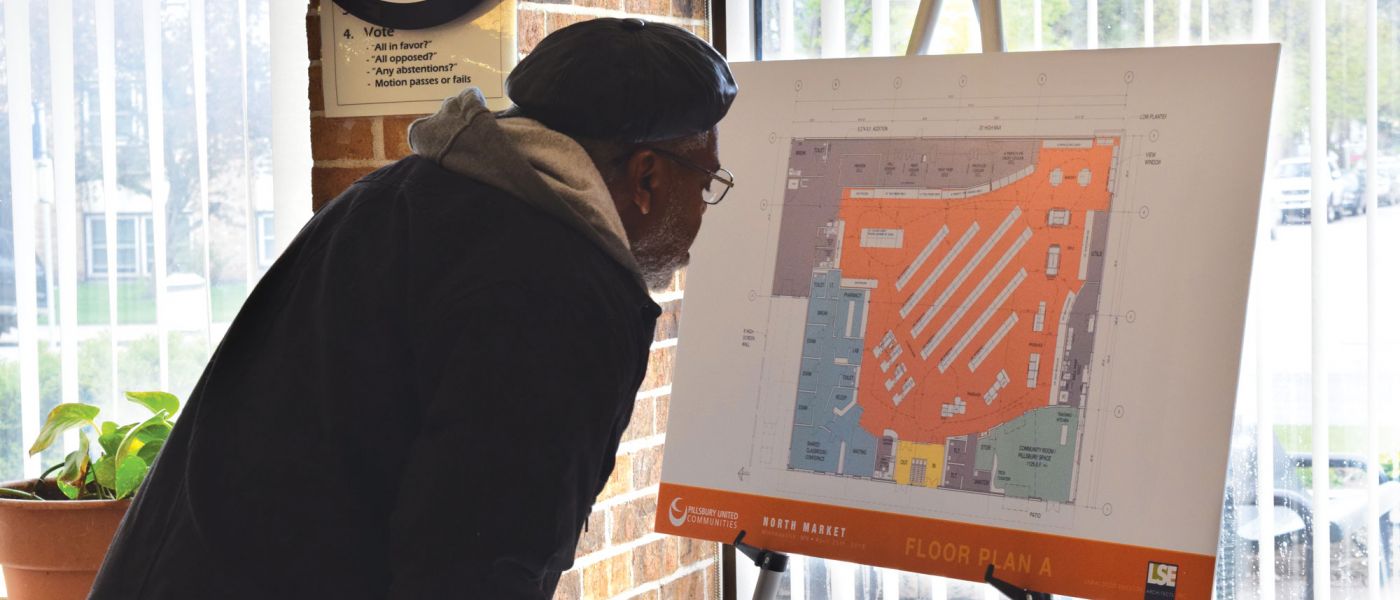Story
In Progress: Creating a Community Oasis
How Pillsbury United Communities uses human-centered design to plan a new kind of grocery store in north Minneapolis


Pillsbury United Communities’ (PUC) North Market project was born when the organization began examining why families in north Minneapolis seemed to ignore the Women, Infants and Children (better known as WIC) food-subsidy program.
At the request of the State Health Department, PUC set out to boost participation in the program; no one dreamed the solution would take the form of a truly innovative grocery store.
“We set out to solve a much narrower problem,” says PUC President and CEO Chanda Smith Baker. “But as we engaged community members in talking about access to healthy food, we began to think more broadly about what we could do as a solution.”
The idea of a grocery store emerged at a time when PUC was thinking through a new strategic framework. “We knew we couldn’t take our work to the next level unless we disrupted our current way of doing business,” says Smith Baker. To that end, PUC Chief Innovation Officer Adair Mosely attended Stanford Institute of Design’s “Design Thinking Bootcamp.” Out of more than 100 participants, Mosely was the only one representing the nonprofit sector. “Human-centered design is being used every day by the private sector to be more competitive and take big risks in the pursuit of innovative solutions,” explained Mosely, “so why is the nonprofit sector not using the same tools and resources?”

Human-Centered Design
Human-centered design process begins with learning how to empathize with the person (or “end user”) whose problem you want to solve. In this case, the average resident of north Minneapolis is more likely to be obese and have a shorter life span than residents in other parts of the city. Smith Baker calls north Minneapolis one of the worst urban food deserts in the nation, pointing to the 30 convenience stores and single grocery store that serve its 67,000 community members. “As we went out and engaged those WIC users, we immersed ourselves in their day-to-day experience,” says Mosely. “We understood what they valued.”
The next phases of the human-centered design process involve using your empathy to define the scope of the problem and develop possible solutions. The best ideas are then manifested in a cost-effective prototype that can be tested with the end users before significant resources are dedicated to a full implementation. PUC used this process to develop, prototype and test its first idea — a mobile grocery store for WIC voucher recipients — before learning from the state that regulations would prevent its idea from being realized.
“At that point, we could have gone back to the old way of doing things,” says Mosely, “and just offered a class for people on how to use their WIC vouchers.” Instead, the team went back through the human-centered design process using a different question: “Is there something larger that we can solve in our community?” This time, they landed on a bigger idea: Open a full-service grocery store that combines wellness support, health services and education with a wide range of fresh and healthy foods in one accessible space.
Collaborative Problem-Solving
PUC’s full commitment to the human-centered design process made it a natural fit for the Bush Foundation’s Community Innovation Grant program. Smith Baker and her team received a $200,000 grant in 2016. “Good ideas don’t just come out of nowhere,” says Community Innovation Director Mandy Ellerton. “At the Bush Foundation, we look for processes that are collaborative and include the folks affected by the problem. We’re really excited by the depth of PUC’s community engagement with North Market.”
While the whole brainstorm and design process for North Market benefited from intensive community involvement, PUC leveraged key organizational relationships with cross-sector partners to further broaden its impact. For example, North Memorial, which operates a hospital near the border of Robbinsdale and north Minneapolis, had been exploring ways to deepen its commitment to preventative and primary care
in the neighborhood. As a tenant in the finished market, it will have a health clinic and offer nutrition and wellness counseling, in addition to medication management therapy geared toward supporting chronic-disease management.
“Our collaboration with North Market helps us align ourselves with the way healthcare is changing,” says North Memorial Care Coordination Manager Emilie Hedlund. “It allows us to test an alternative model for community healthcare access.” She notes that the status quo involves waiting for patients to come to a clinic or the hospital, often in a state of illness or health crisis. “We’re excited to try this new way of engaging with the community, where we come to them, so we can address some of the social factors that are core to someone’s health but can be hard for us to tackle in clinic visits.”
Local human-centered design firm bswing, a key partner from the business sector, has been instrumental in guiding PUC and North Memorial through the design process in a way that keeps the focus on the end user. “We’re helping them get into the community and talk with community members to build engagement around their health needs,” explains bswing CEO and Bush Foundation board member Jen Alstad. “We help bring the design concepts to life — what the health programming looks like, what services are delivered in the space and how it all supports a new way of healthcare working with community.”
Breaking Ground
Purchased in November 2016, the land and building that will house North Market is the site of a former Kowalski’s grocery store. The project hopes to break ground summer of 2017, with a scheduled opening in the fall of 2017. It will feature 16,000 square feet of grocery retail space with an extra spacious and prominent fresh produce section; a community space for cooking classes, food demonstrations and product launch parties where local entrepreneurs can offer their products; and a health and wellness space staffed with physicians, pharmacists, community paramedics, a dietician and a nutritionist.
The market and wellness center will create 25 retail jobs that offer livable wages, and infuse the local economy with $3.6 million in revenue each year. The aim is for the grocery store to be self-sustaining after a year of operations, while PUC will continue to support the health and wellness programming.
“There’s a lot of interest in figuring out how to solve north Minneapolis’ problems,” says Smith Baker. “Because PUC has worked with the community for so long — we’re invested in it; we have relationships here — they’ve really embraced this project. They’re looking forward to having this asset near where they live and work.”
Many people within the health and wellness field have embraced North Market as well and are interested to see how the model moves forward. “There’s potential for scaling this model to other communities, or presenting about how we arrived at this concept,” says Smith Baker. Mosely agrees: “With North Market, we’ll have a model that is scalable for rural and urban areas to deal with access to healthy foods, and the intersection of food and health overall. We’ll have breakthroughs to offer, and by supporting this process, the Bush Foundation is helping us do just that.”
Continue reading
-

Story
Initiating changemakers
How the Initiators Fellowship supports business enterprises that prioritize social and environmental good throughout Greater Minnesota.
-

Note from Jen
Note from Jen: Acknowledging and learning from the boarding school era
The Bush Foundation was invited to the gathering at Gila River...
-

News
Meet the 2024 Bush Prize winners!
Bush Prize winners are doing big things in partnership with their communities.